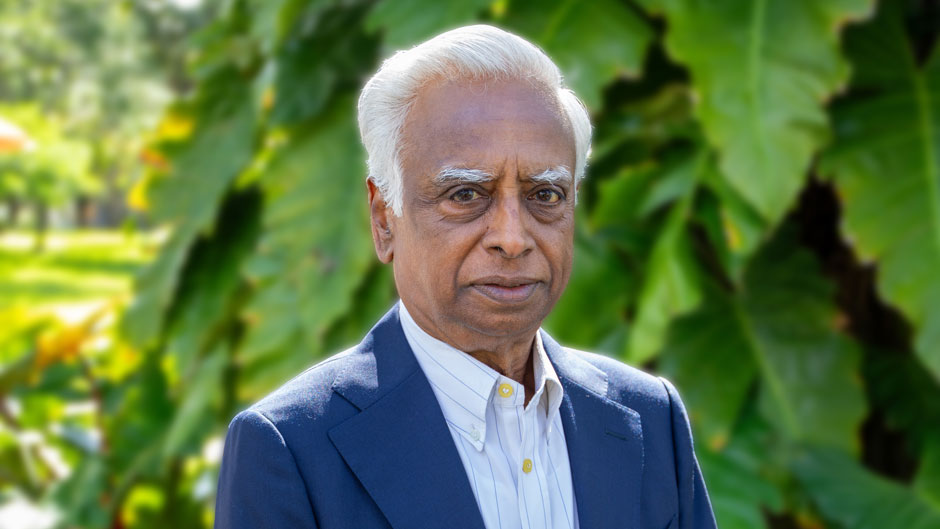When Vaidhyanathan Ramamurthy was growing up, he would periodically experiment with light. At age 6, he would focus sunlight through a keyhole with the help of a mirror, ask his younger sister to dance between the keyhole and the mirror, and marvel that he could see her actions upside down “like a movie” on the other side of the door.
“Without even knowing the science behind it, light interested me in those early days,” said Ramamurthy, a professor in the Department of Chemistry at the University of Miami College of Arts and Sciences whose research focuses on chemistry initiated by light. “Now the question is how to use light to benefit us.”
Photochemistry, the study of the chemical effects of light, has a variety of applications related to photosynthesis, vision, the capture and release of solar energy, and the mitigation of environmental pollution due to chemicals and plastics.
“There is nothing more sustainable than sunlight,” Ramamurthy said. “If we can use it and do chemistry in a safe manner, it will play an important role in the life of this planet. Also, if we learn to convert sunlight into more useful forms, life on Earth would be safer with fewer conflicts and more sustainable.”
Educating future generations about the value of light in society is one of Ramamurthy’s motivations for teaching photochemistry to students at the University as well as other universities in the United States, India, China, and Japan. The success of this effort has motivated him to reach out to students in Europe as well.
Ramamurthy was recently awarded a Fulbright grant to share his knowledge of photochemistry with students and researchers in the Czech Republic. From September 2024 to January 2025, he will be teaching a photochemistry course at Masaryk University, the second-largest university in the Czech Republic, and collaborating on research involving light in chemistry.
Prior to joining the University of Miami in 2005, Ramamurthy earned his Ph.D. at the University of Hawaii, completed post-doctoral fellowships at the University of Western Ontario in Canada and Columbia University in New York, and taught at the Indian Institute of Science in Bengaluru and Tulane University in New Orleans, Louisiana. He has also worked at DuPont, an American multinational chemical company, in Wilmington, Delaware.
This is Ramamurthy’s third time being a Fulbright grantee. Two previous grants took him to India, where he worked closely with students and teachers at the Indian Institute of Technology in Chennai and the Indian Institute of Science in Bengaluru, two places where he had previously studied and served as a faculty member. He also used the fellowships to travel extensively within India, visiting over thirty institutions to give lectures on his research.
In his classes, Ramamurthy not only educates students on the fundamentals of photochemistry, but also provides background on the history of prominent scientific figures and scientific discoveries. He likes to highlight the process of discovery because he believes that finding answers to questions such as how discoveries are made, what motivates scientists to make discoveries, and what is needed to make a breakthrough in science are important to the growth of science and engineering. Ramamurthy’s heroes in science are Michael Faraday, James Maxwell, and Max Planck, who all contributed to the modern understanding of light.
As a professor in the Department of Chemistry for nearly 20 years, an editor of numerous monographs and textbooks, a writer of over 400 research publications, and an executive editor of the American Chemical Society journal Langmuir, Ramamurthy is especially interested in conducting research aimed at understanding nature and basic science.
“I get excited when I make a discovery and publish a scientific article based on that,” he said. “Although these are small things, they make me and my students happy. At the end, what matters is that we are training inquiring minds.”

